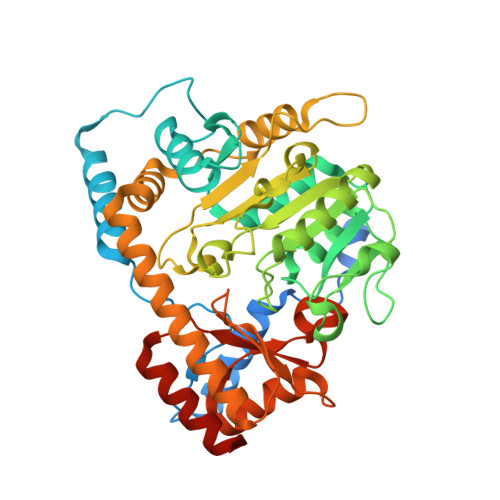L,L-Diaminopimelate Aminotransferase from Chlamydomonas reinhardtii: A Target for Algaecide Development
Dobson, R.C.J., Giron, I., Hudson, A.O.(2011) PLoS One 6: e20439-e20439
- PubMed: 21633707
- DOI: https://doi.org/10.1371/journal.pone.0020439
- Primary Citation of Related Structures:
3QGU - PubMed Abstract:
In some bacterial species and photosynthetic cohorts, including algae, the enzyme L,L-diaminopimelate aminotransferase (DapL) (E.C. 2.6.1.83) is involved in the anabolism of the essential amino acid L-lysine. DapL catalyzes the conversion of tetrahydrodipicolinate (THDPA) to L,L-diaminopimelate (L,L-DAP), in one step bypassing the DapD, DapC and DapE enzymatic reactions present in the acyl DAP pathways. Here we present an in vivo and in vitro characterization of the DapL ortholog from the alga Chlamydomonas reinhardtii (Cr-DapL). The in vivo analysis illustrated that the enzyme is able to functionally complement the E. coli dap auxotrophs and was essential for plant development in Arabidopsis. In vitro, the enzyme was able to inter-convert THDPA and L,L-DAP, showing strong substrate specificity. Cr-DapL was dimeric in both solution and when crystallized. The structure of Cr-DapL was solved in its apo form, showing an overall architecture of a α/β protein with each monomer in the dimer adopting a pyridoxal phosphate-dependent transferase-like fold in a V-shaped conformation. The active site comprises residues from both monomers in the dimer and shows some rearrangement when compared to the apo-DapL structure from Arabidopsis. Since animals do not possess the enzymatic machinery necessary for the de novo synthesis of the amino acid L-lysine, enzymes involved in this pathway are attractive targets for the development of antibiotics, herbicides and algaecides.
- Department of Biochemistry and Molecular Biology, Bio21 Molecular Science and Biotechnology Institute, The University of Melbourne, Parkville, Victoria, Australia.
Organizational Affiliation:



















